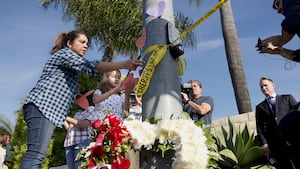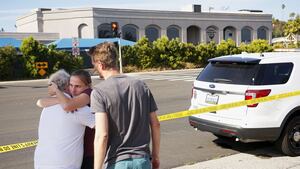The alleged killer at a Southern California synagogue this weekend worked alone, according to law enforcement, but behind him is a sprawling, digital network of white supremacists spurring each other on to murder.
Moments before allegedly opening fire at worshippers in Chabad of Poway on Saturday, white supremacist John Earnest previewed his plans on 8chan, just as his supposed inspiration did. Last month, a white supremacist in Christchurch, New Zealand used 8chan to share a link to a livestream of him killing 50 Muslims at a mosque. In between the attacks, the anonymous forum with a large fascist presence called for people to carry out more shootings. The calls for violence also spread across fringe platforms like Gab, and messaging apps like Telegram. It’s reminiscent of calls online for followers of ISIS and al Qaeda to strike out at the enemy, counter-terrorism experts said.
After the New Zealand shooting, 8chan users decorated the alleged killer as a “saint” and encouraged each other to commit shootings of their own, including against synagogues, to prepare for the “third world war” against Jews, or to kill a journalist critical of the forum.
“As a lot of people have noted over the past few days, 8chan is an awful cesspool of encouraging violence and hatred,” said Sam Jackson, an assistant professor focusing on online extremism at the University of Albany. “That hate and encouragement of violence might be a sort of baseline, background noise, but periodically someone moves from participating in this online awfulness to committing offline actions.”
Those real-life actions appear to have spiked over the past six months, with at least three white supremacists announcing attack plans on 8chan or Gab, before opening fire at Jewish or Muslim houses of worship. Three such attacks—at a Pittsburgh synagogue, a Christchurch mosque, and at the Poway synagogue—have killed a combined 62 people in the past six months.
That background noise can act as a war drum for violence. White supremacist communities often use memes to normalize extreme violence. Almost immediately after the San Diego shooter warned of his attack on 8chan, forum-goers treated the mass-shooting like a game.
The first response to his 8chan post urged him to “get the high score,” investigative outlet Bellingcat noted. (When only one person, 60-year-old Lori Gilbert Kaye, was murdered, some 8chan users lamented the attack’s “low score.”)
The online-inspired terror, and its instant repackaging as propaganda, was pioneered by ISIS and al Qaeda. And unlike Islamic extremism, white supremacist terror appears to hold a place of middling concern in the Trump administration.
“It’s interesting: we fretted so much about al Qaeda and ISIS online, and we’ve got a massive white supremacist network online right now,” said Clint Watts, a former FBI agent on the Joint Terrorism Task Force.
“The technology has evolved over the last few years,” said Watts, who traced in real-time propaganda from groups like ISIS and Al-Shabaab in his role a distinguished research fellow covering terrorism and social media at the Foreign Policy Research Institute.
Groups like al Qaeda “used to film their attacks, or parts of them. Some good examples are the Westgate attack of al-Shabaab in Nairobi in 2013. They were live-tweeting out updates during the attack. Fast forward to ISIS a couple years later—they would be shooting video and quickly uploading it during 2013-2014. But ISIS was mostly kicked off the mainstream platforms by the time live video uploads were available.”
Nazis, meanwhile, have found more staying power online.
Forums like Gab and 4chan’s far-right /pol/ board appear to have grown steadily more hateful since President Donald Trump’s election, research by the Anti-Defamation League found earlier this month.
In these forums and others, users can be observed spreading anti-Semitic conspiracy theories with the stated goal of inciting a reader to violence.
After the San Diego shooting, Twitter user AntiFash Gordon uploaded screenshots of members of a violent white nationalist Telegram channel agitating for “pogroms.”
“thats the thing with memes about jews,” one user wrote on Telegram. “does it matter if theyre true? their consequences are pogroms and thats what matters at the end of the day.”
Not even experts can predict who will kill next. Studies of so-called “lone wolf” terrorists have produced few common characteristics besides “young and male,” Watts said.
Jackson added that researchers at University College London conducted “a study where they found lone wolf actors have a slightly higher chance of having some sort of mental illness, but it’s not even a huge number.”
Perhaps surprisingly, the series of terror attacks have happened in a slow moment for open white supremacist organizing. After 2017’s deadly white supremacist rally in Charlottesville, Virginia, a number of the movement’s stars have fallen and its most prominent groups have imploded or gone underground. Opposition from anti-fascists in the streets and lawsuits in the courts has smeared the public-friendly face some racists hoped to present before 2018.
Sometimes movements under pressure will resort to terrorism, Watts said, comparing the movement to al Qaeda after a law enforcement crackdown.
“By the time it was like 2009, the real threat was inspired terrorism,” he said, by extremist preachers “like Anwar al-Awlaki. He’d post a message telling people to do attacks at home, and people would pick up arms and do attacks at home. You’re seeing a refined version of that.”
Jackson, meanwhile, attributed the apparent spikes in white supremacist attacks to “a contagion effect,” adding that “it’s also possible that the attention that previous attackers have got from mainstream sources encourages others to make a name for themselves in similar sorts of acts.”
The white supremacist movement’s online footprint is a sign of its terror potential. Whereas ISIS supporters might succeed in uploading a limited number of ISIS videos to social media, footage of the Christchurch shooting went viral immediately after the attack. In the 24 hours after the mass shooting, Facebook recorded 1.5 million attempts to upload the video.
ISIS might be a favorite Trump talking point, but the 1.5 million Christchurch video uploads suggest a much larger following for white supremacist terror.
“You can tell that the global network of white supremacist terrorism is pretty damn strong right now, because they keep uploading, they keep talking about it, and the pace of attacks continues to speed up,” Watts said.
“That’s a bad sign. If we were talking about inspired ISIS or al Qaeda attacks, all lights would be blinking bright red right now.”








